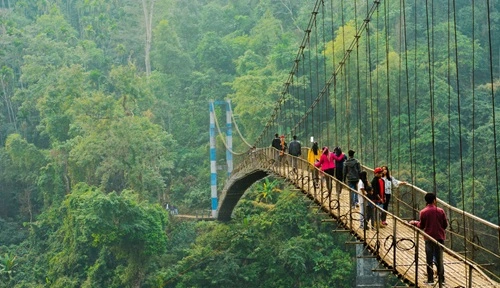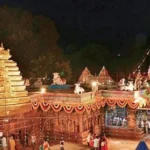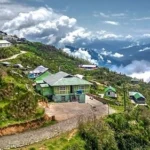Cherrapunji, nestled in the Indian state of Meghalaya, is renowned for its extraordinary rainfall and surreal landscapes. Known as “Sohra” by locals, this town holds the title as one of the wettest places on Earth. With lush greenery, cascading waterfalls, mysterious caves, and the world-famous living root bridges, Cherrapunji is a destination unlike any other. However, the timing of your visit can dramatically alter your experience, as Cherrapunji’s weather is as intense as its natural beauty.
To help you plan your trip to this enchanting destination, here’s a comprehensive guide on the best time to visit Cherrapunji, including seasonal insights, activities, and travel tips.

1. Climate Overview: Cherrapunji’s Unique Weather Patterns
Cherrapunji has a subtropical highland climate, which means rain plays a central role in defining its environment. There are three primary seasons in Cherrapunji: summer, monsoon, and winter, though rain is almost always present to some degree. This climate creates a unique tapestry of seasons and makes it critical to choose the right time for your visit.
- Summer (March to May): Summers in Cherrapunji are mild, with temperatures ranging between 15°C to 25°C (59°F to 77°F). This season provides comfortable weather with occasional rainfall.
- Monsoon (June to September): This is the most iconic season in Cherrapunji, as it experiences heavy, nearly constant rainfall. With relentless showers, the landscape turns a lush green, and the waterfalls swell to their full grandeur.
- Winter (October to February): Winters are relatively cool, with temperatures ranging from 10°C to 20°C (50°F to 68°F), and rainfall significantly decreases. This season offers the clearest skies and excellent visibility, making it ideal for sightseeing.
2. Ideal Time to Visit Cherrapunji
For most travelers, the best time to visit Cherrapunji is during the winter months, from October to February. Let’s dive deeper into why winter stands out as an ideal time to explore this region.
A. Milder Weather and Comfortable Temperatures
With cooler, less humid weather, winter in Cherrapunji is refreshingly pleasant, especially when compared to the intense downpours of the monsoon. You can explore the stunning landscapes without worrying about getting drenched every hour, and it’s easier to navigate through trails, villages, and outdoor attractions.
B. Better Visibility and Clear Skies
Winter provides excellent visibility, which is rare in a place known for constant mist and rain. With clearer skies, the views of the surrounding hills, valleys, and waterfalls are spectacular. You can fully appreciate the scenic beauty, take panoramic photographs, and even enjoy the starry nights—something that’s not easily possible during the monsoon season.
C. Access to Major Attractions
During winter, many attractions such as the Nohkalikai Falls, Mawsmai Caves, and the famous double-decker living root bridges become more accessible. Paths that may be slippery and dangerous in the monsoon are safer, allowing visitors to explore with ease. While the waterfalls might not be at their most ferocious, they still offer a magnificent sight, and you can explore them without battling heavy rain.
3. Other Seasons: What to Expect
Though winter is the preferred season, each time of year offers a unique perspective on Cherrapunji. Here’s a look at what summer and monsoon have to offer:
A. Summer (March to May):
Summer can be a good time to visit Cherrapunji, as temperatures are mild and the region experiences a moderate amount of rainfall.
- Lush Scenery: With sporadic rain showers, the hillsides stay green, and the waterfalls are in full flow, though not as overwhelming as during the monsoon.
- Milder Crowds: Compared to the winter holiday season, summer attracts fewer visitors, so you can enjoy a relatively quieter experience.
- Festivals: The locals celebrate Easter and Shad Suk Mynsiem (a traditional Khasi spring festival) around this time, which offers a unique cultural experience for visitors interested in learning about local traditions.
B. Monsoon (June to September):
Cherrapunji comes alive during the monsoon season, showing the world why it’s known as one of the rainiest places on Earth.
- Nature at Its Peak: The landscape turns emerald green, waterfalls are at their most dramatic, and the forests and rivers are brimming with life. Nohkalikai Falls, Seven Sisters Falls, and Dainthlen Falls become truly majestic sights during these months.
- Thrilling Yet Challenging: However, the heavy rains make travel more challenging. Roads can be slippery, and outdoor activities like trekking to living root bridges become difficult. You may need rain gear at all times, and sudden landslides can cause temporary road closures.
- Best for Rain Lovers: For those who love rain and adventure, visiting Cherrapunji during the monsoon is a unique experience. The intensity of the rains is both mesmerizing and humbling, reminding you of nature’s powerful beauty.
4. Tips for Visiting Cherrapunji
No matter the season, here are some essential tips to enhance your trip to Cherrapunji:
- Pack Smartly: Cherrapunji’s weather is unpredictable, and rain can occur even in the winter. Bring waterproof gear, quick-dry clothes, and sturdy shoes with good grip to navigate wet paths.
- Stay Hydrated and Prepared: Despite the cool weather, walking through the hilly terrain can be exhausting. Carry water, snacks, and a small first-aid kit, especially if you’re heading to remote spots like the living root bridges.
- Respect Local Culture and Environment: Cherrapunji is home to the Khasi people, who follow traditional customs and are known for their environmental consciousness. Be mindful of local customs, avoid littering, and respect the pristine natural surroundings.
- Explore Beyond the Usual: While popular attractions are a must-see, also take time to explore nearby villages like Mawlynnong (Asia’s cleanest village) and Dawki for a peaceful experience and beautiful river views.
Conclusion
Cherrapunji is a destination that offers a dramatic showcase of India’s northeastern beauty, combining lush greenery, incredible rainfall, and a rich cultural heritage. While winter offers the best mix of accessibility and pleasant weather, each season brings its own charm and unique adventure. For rain lovers, monsoon presents a thrilling encounter with nature’s raw power, while summer offers moderate crowds and vibrant landscapes.
Whichever season you choose, a visit to Cherrapunji will leave you captivated by its rugged, rain-kissed beauty. It’s a place where nature reigns supreme, and every traveler leaves with memories as vivid and untamed as the land itself.


